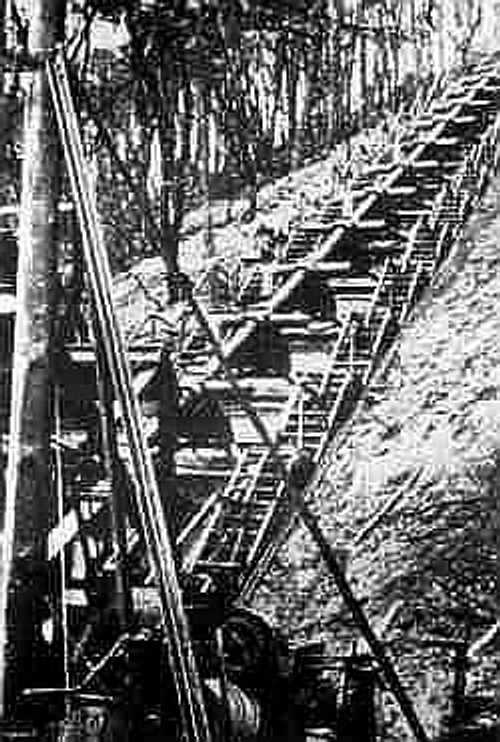
German Artillery
"High Pressure Pump"
Yes, it does look a bit like part of a sewerage system, but this in fact a prototype for the V-3 German "vengeance weapon". There was little technological synergy between the "V" weapons. The V-1 was a pulse-jet powered unmannned flying bomb; the V-2 was a ballistic missile. V-3 was a "supergun" - the sort of thing Saddam Hussein was to attempt in more recent times. The idea was to launch a fairly large explosive projectile (155 mm) over a very long distance, this to be achieved by using a very long barrel (150 metres) fitted with paired booster breaches along its length. Following the initial ignition of the main charge, subsidiary charges would ignite in the booster breaches, timed to go off just after the projectile passed them, maintaining and adding to the velocity of the projectile. The resulting array of main barrel and side-breeches gave the weapon something of the appearance of a millipede - hence the other German codename (along with "high pressure pump" )of "Tausendfussler". Speer, then Hitler, took an interest in the project. Having accepted the basic feasibility of the idea following initial prototype trials, Hitler projected a grandiose project involving multiple batteries of "pumps" aimed permanently at London - a target well within the 165 km. projected range of the V-3. "Grandiose" because each battery of these things would have required the construction of a large concrete/stone-cut bunker complex with elaborate underground servicing in a suitable location in north-western France - a very tall order for German industry and transport capacity at the time. The superguns themselves, of course, would have been fixed in place, incapable of adjustment in targeting except, perhaps, by varying propellant charges. In the end, the project came to nothing. Disruption of transport, shortages in raw material and setbacks in development reduced the project, in the end, to a projected single battery of full-size superguns to be located at Mimoyecques, Pas de Calais. Even this did not come about. The Allies, alerted by the unusual appearance of the installation, already had it under air attack well before any weapon was ready for installation. Without realising it, RAF 617 Squadron effectively ended the V-3 project when their payload of Tallboy ("earthquake") bombs caused severe damage to the bunker structure. A mini-supergun was subsequently used against the city of Luxembourg, but to no great effect. By the way - with reference to the inappropriate posting of other "superguns", or "high pressure pumps" on this site - I agree with a previous poster who suggested that commenting directly on this sort of thing might be avoided as it only proliferates the offending images, thus feeding the troll. I think we can rely on moderators to do the right thing in such cases ... Best regards, JR.
3849 Views
9/16/2010
